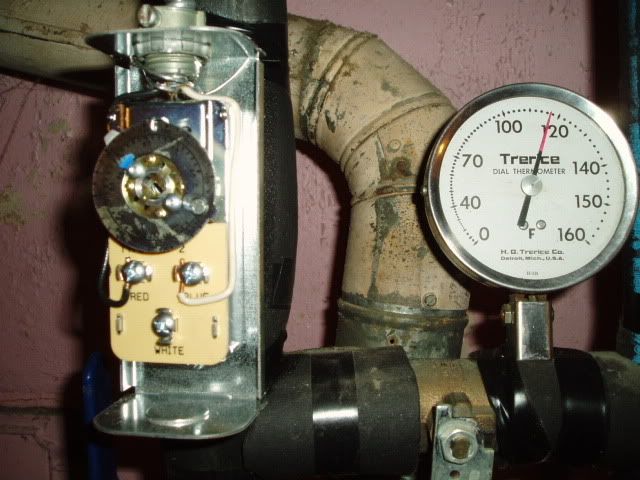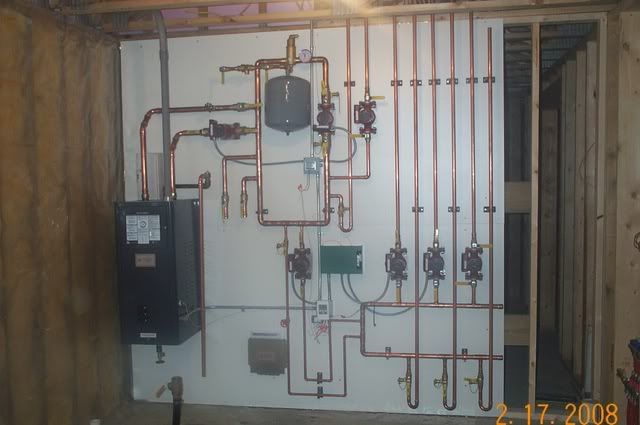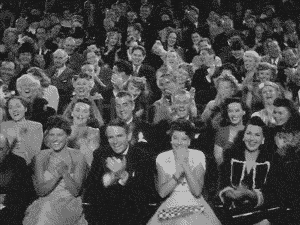jaimz23 wrote:Sting
What I am confused about is if I am to wire it to run at 145 and a call for heat and to stop at 140 degrees, this denotes connecting it to the aquastat and not the thermostat unless you have a Thermostat that goes to 145...and I am unsure of where exactly on the aquastat to connect it to to energize the relay coil and and get the contacts to close???? (Carol didn't cover this in her book only relay connection to thermostats and the loads) Also, if I needed to use 3 relays, one for each case (145, call for heat, and off at 140) where will all of these different 24V signals be coming from?

OK - you see the benefit of reading a little first ; and now disguised as a toilet seat - you will get more tail than I --
or
what your missing here is your signal generator - commonly referred to as an Aquastat. Something like this:

I have the cover off this one so you can see the wiring - its wired to OPEN the 120 volt signal to the pump that charges my domestic hot water tank to 120 degrees - so.... when the tank gets to 120 this switch (aquastat) opens and stops the pump. Now these have a differential - the amount of temperature that the switch rests prior to reaction to temperature rise and fall. Some are adjustable. This could just as easily be a 24 volt signal controlling a zone valve and sending a 24 volt signal to another relay that opens and closes a 120 volt signal to a pump and so on and so on.
These will control ONE 24 volt control signal or circuit or ONE 120 volt circuit (or one hi voltage signal if your using 120 volt ice cube relays) more on this below
In your case above - you will find a place to strap on one of these like I did here, only set at about 140-145 - or your will have or create a temperature well in a fitting close to the boiler - to place the probe of one of these and wire the circulator pump ( or possibly you will use the C1 and C2 terminals of the triple aqustat on your coal boiler to do the same - but I don't like that - more on this later. There are many ways to do this just like Windows. Read a little more about the boiler controls.
The goal is - you don't want to send cold water into your hot boiler to shock it and you don't want to run your boiler below 140 or you will get corrosive condensation. And you don't want to pump the boiler when there is no call for heat to the load, because that wastes pump and boiler energy.
Do a search for boiler protection.
This is how its done the simple way.

Lots of folks make expensive logic controls that cost zillions, and are impossible to repair on a Sunday evening while the Packers game is on. I have sort of a "distaste" for that.
Now these signal generators (aquastat) can control one device pump valve etc. They are a single pole single throw - normally open or normally closed switch. When you daisy chain signals - lets say this must happen before this can - you use relays to isolate signals from one another so that doesn't cause this to happen before that. and so on. I have to make you read the books and search a little more or Ill be writing the book here.
jaimz23 wrote:Last, for my N.C. Zone control valve in the dump zone (in my diagram) do they only run on 24V or are they available in 120V or do I need to plug 120V into a step down transformer to get 24V to power the N.C. zone control valve
Ice cube relays can be purchased that do this any way you want.
http://www.grainger.com/Grainger/wwg/search.shtml ... sst=subset
or
http://www.grainger.com/Grainger/WHITERODGERS-Fan ... Pid=search
It depends
Let me get back to you

or better -- Lets get YANCHE to take a swing here.







